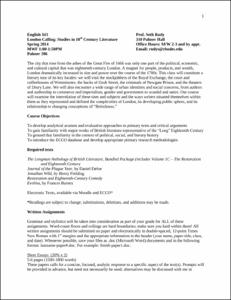Please use this identifier to cite or link to this item:
http://hdl.handle.net/10267/20132Full metadata record
| DC Field | Value | Language |
|---|---|---|
| dc.contributor.author | Rudy, Seth | - |
| dc.date.accessioned | 2014-03-27T15:28:45Z | - |
| dc.date.available | 2014-03-27T15:28:45Z | - |
| dc.date.issued | 2014-01-08 | - |
| dc.identifier.uri | http://hdl.handle.net/10267/20132 | - |
| dc.description | This syllabus was submitted to the Office of Academic by the course instructor. Uploaded by Lorie Yearwood. | en_US |
| dc.description.abstract | Once the entirety of London, the City that rose from the ashes of the Great Fire of 1666 was only one part of a political, economic, and cultural center that continued to expand in population and power over the course of the eighteenth century. This class will explore the complexities of London’s developing public sphere and its relationship to changing conceptions of “Britishness” by taking a literary tour of its key locales. We will not be anchored to time, but rather to space; we will take for our model John Gay’s “Trivia; or the Art of Walking the Streets of London,” and proceed through different districts of the city as we examine the ideas represented by those districts and the ways those districts were represented in a wide range of literatures. To mention the parish of St Giles in the mid-eighteenth century was to invoke poverty and drunkenness; Westminster and Whitehall meant the seats of government power. Grub Street was synonymous with hacks and partisan writers, Newgate with criminals and crime; Drury Lane was the center of the theatrical world, and the Royal Exchange the center of commerce. All, however, were London. These locations throughout the City, Court, and Town were the sites and symbols of an ongoing debate about the status of British literature, history, and culture. In addition to an extensive selection of readings that will include periodicals, poems, prose fiction, and plays by authors such as Dryden, Ward, Gay, Addison and Steele, Haywood, Defoe, Pope, Swift, Fielding, Sheridan, and Burney, the course will make use of digital technologies available to eighteenth-century scholars. The Eighteenth Century Collections Online (ECCO) database provides electronic access to thousands of documents that will expand the literary cityscape beyond the canonical entries of modern anthologies and presses, and Locating London’s Past will help to place them on a Geographic Information System compliant version of John Rocque’s 1746 map. These texts and tools will allow us to situate in time and space contemporary issues of urban identity, social mobility, authorship, imperialism, gender, scandal, and satire. Prerequisites: Any 200-level literature course or permission from instructor. | en_US |
| dc.language.iso | en_US | en_US |
| dc.publisher | Memphis, Tenn. : Rhodes College | en_US |
| dc.relation.ispartofseries | Syllabi CRN 24305; | - |
| dc.rights | Rhodes College owns the rights to the archival digital images in this collection. Objects are made available for educational use only and may not be used for any non-educational or commercial purpose. Approved educational uses include private research and scholarship, teaching, and student projects. Original copies of the programs are stored in the Rhodes College Archives. In all instances of use, acknowledgement must be given to Rhodes College Archives Digital Repository, Memphis, TN. For information regarding permission to use this image, please email the Archives at archives@rhodes.edu | - |
| dc.subject | English, Department of | en_US |
| dc.subject | Syllabus | en_US |
| dc.subject | Academic departments | en_US |
| dc.subject | Curriculum | en_US |
| dc.subject | Text | en_US |
| dc.subject | 2014 Spring | en_US |
| dc.title | ENGL 343, London Calling: Studies in 18th Century Literature, Spring 2014 | en_US |
| dc.type | Syllabus | en_US |
| Appears in Collections: | Course Syllabi | |
Files in This Item:
| File | Description | Size | Format | |
|---|---|---|---|---|
| 2014_SPRING_ENGL_343_01_24305.pdf | 222.92 kB | Adobe PDF |  View/Open |
Items in DSpace are protected by copyright, with all rights reserved, unless otherwise indicated.